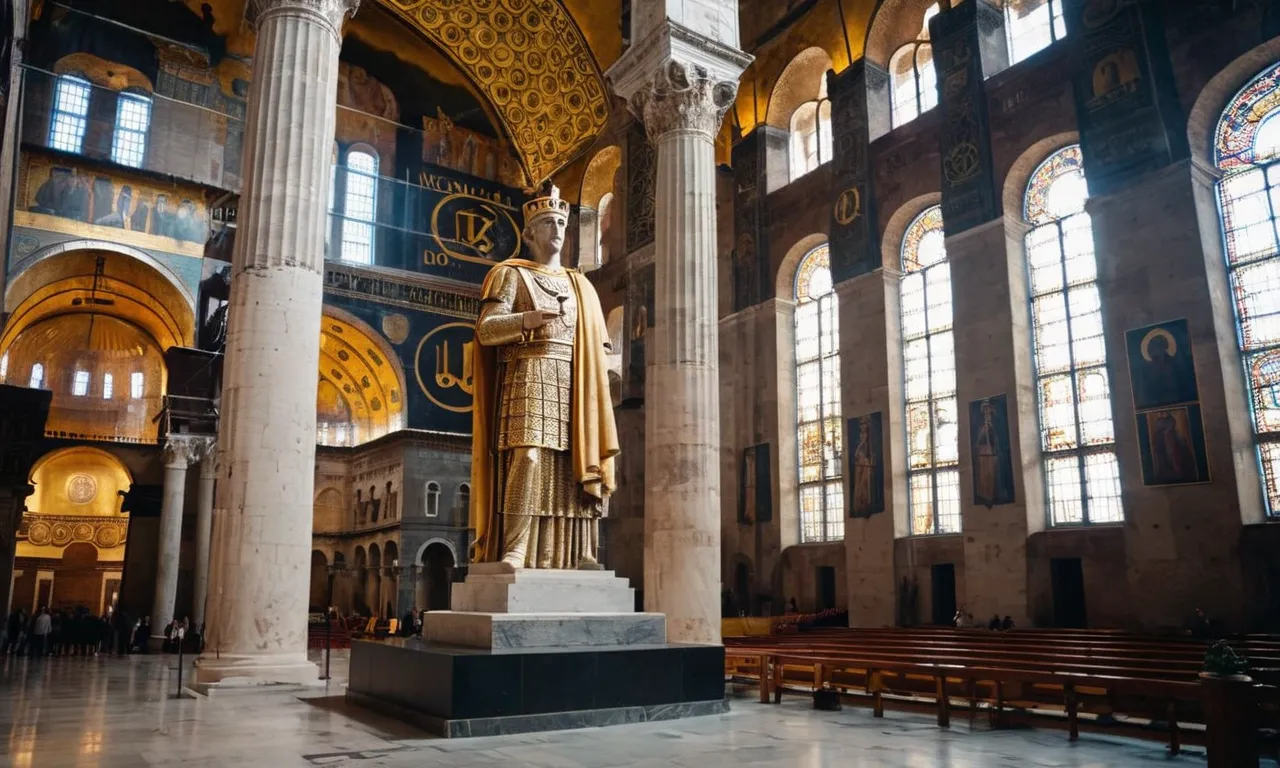Who Was The First Emperor Of The Byzantine Empire?
The Byzantine Empire, also referred to as the Eastern Roman Empire, was the continuation of the Roman Empire in its eastern provinces during Late Antiquity and the Middle Ages. If you’re short on time, here’s a quick answer to your question: The first emperor of the Byzantine Empire was Emperor Constantine I, also known as Constantine the Great, who ruled from 306 to 337 AD.
In this comprehensive article, we will explore the story of how Constantine rose to power, the key events during his reign, his lasting impacts and legacy as the founder of Constantinople (modern-day Istanbul), and more details about the origins and history of the Byzantine Empire over which he presided as its first emperor.
Constantine’s Rise to Power in the Roman Empire
His early life and path to becoming caesar
Constantine was born around 280 AD in Naissus, which is present-day Niš in Serbia. His father, Constantius Chlorus, was a Roman officer who would later become one of the four rulers of the Tetrarchy. As a child, Constantine received military training and joined his father on campaigns in the east.
When Constantius became caesar in 293 AD, Constantine was taken as a hostage to the court of Diocletian, the senior emperor. This gave him valuable experience in politics and exposure to the inner workings of the empire.
In 305 AD, Constantius succeeded Maximian as augustus in the west. The following year, Constantine escaped the court of Galerius, the eastern augustus, and joined his father in Gaul. Constantius died soon after in 306 AD, and Constantine was proclaimed augustus by his father’s troops.
However, Galerius refused to recognize him as augustus and acknowledged him only as caesar. Constantine accepted this compromise for the moment.
Winning sole leadership through civil wars and conflicts
After Constantine’s proclamation, multiple claimants vied for control in the resulting power vacuum. Maxentius, the son of Maximian, declared himself emperor in Italy. Constantine allied with Licinius to defeat Maxentius.
In 312 AD, Constantine invaded Italy and confronted Maxentius’ forces at the Battle of the Milvian Bridge. According to legend, Constantine had a vision before this battle promising victory if he fought under the sign of Christ.
He ordered his soldiers to paint Christian symbols on their shields and won a decisive victory against Maxentius. This paved the way for Constantine to become the sole ruler in the west.
Conflict soon erupted between Licinius and Constantine. Licinius renounced the religious freedoms Constantine allowed Christians in the west. After years of tension, Constantine waged war against Licinius in 324 AD, emerging victorious the following year.
This left Constantine as the sole ruler of a reunified Roman Empire.
Defeating rivals Maxentius and Licinius
Constantine first defeated his rival Maxentius at the Battle of the Milvian Bridge in 312 AD. Maxentius drowned while retreating across the Tiber River after his troops were routed. This ended his bid for power and allowed Constantine to consolidate control over Italy and the western provinces.
Constantine’s later conflict with Licinius also ended in victory. He defeated Licinius in 324 AD at the Battle of Adrianople using a wedge formation to break through the enemy’s defensive lines. The next year, in 325 AD, Constantine’s navy destroyed Licinius’ fleet at the Battle of Hellespont.
After this naval defeat, Licinius surrendered and Constantine became sole emperor.
By defeating these two rivals, Constantine eliminated all threats to his power and laid the foundations for the Byzantine Empire. His military successes enabled him to reunify the Roman Empire after years of civil war.
Key Events and Actions During Constantine’s Reign
Issuing the Edict of Milan
In 313 CE, Constantine and his co-emperor Licinius issued the Edict of Milan, which granted religious tolerance to Christians in the Roman Empire. This momentous decree ended the prior persecution of Christians and allowed them to openly practice their faith.
The Edict proclaimed “that Christians and all others should have freedom to follow the mode of religion of their choice” (Fordham University). This paved the way for Christianity to become the dominant religion in the Empire over the next centuries.
Convening the First Council of Nicaea
In 325 CE, Constantine convened the First Council of Nicaea, gathering over 300 bishops from across the Empire. This first ever ecumenical council of the Christian church established important doctrines such as the divinity of Jesus.
It also represented a major increase in imperial involvement in church affairs. According to the Catholic Encyclopedia, this council was “the first effort to attain consensus in the church through an assembly representing all of Christendom” (Catholic Encyclopedia).
Establishing Constantinople as New Imperial Capital
In 330 CE, Constantine established a new imperial capital at Constantinople (modern-day Istanbul). This strategic location on the Bosporus strait between Europe and Asia became the center of the eastern Roman Empire for over 1,000 years.
Constantine invested heavily in the city, building forums, churches, libraries, baths, ports, and other infrastructure. According to Britannica, “Within 6 years public and private buildings emerged, including the Senate house, libraries, churches, palaces, baths, porticoes, and markets” (Encyclopedia Britannica).
As the first Christian emperor, Constantine prioritized the construction of Christian sites and imbued the city with Christian symbols.
Constantine’s Legacy and Impact on the Byzantine Empire
Spreading Christianity in the Roman world
Emperor Constantine the Great played a pivotal role in the spread of Christianity across the Roman Empire in the 4th century AD. After gaining sole control of the empire, Constantine issued the Edict of Milan in 313 AD, which legalized Christianity. This ended many years of persecution of Christians.
According to historians, Constantine converted to Christianity after receiving a vision of a flaming cross before a key battle. After his conversion, Constantine promoted Christianity actively within the Roman state.
Constantine funded the building of numerous Christian basilicas and churches across the empire, including the famous Church of the Holy Sepulchre in Jerusalem. Christianity became a favored religion across the Roman world during his reign.
By the time Constantine died in 337 AD, Christianity had become the dominant faith in many parts of the empire.
Influencing culture, religion and art
As a Christian emperor, Constantine had a profound influence on culture, religion, and art within the empire. He depicted Christian symbols like the Chi Rho on coins and commissioned artworks showing Biblical scenes and Christian imagery.
Many aspects of Greco-Roman polytheism were blended with Christianity during this era.
Constantine also promoted Christians to high-ranking offices during his rule. Key administrative positions were given to bishops and priests. As a result, the early Catholic Church gained significant political influence within the Roman state.
Thus, Constantine set the stage for Christianity to become the official state religion less than a century later, in 380 AD under Emperor Theodosius I. Theodosius officially banned Greco-Roman polytheistic practices which further established Christianity across the Roman Empire.
Setting up imperial succession system in the East
As Constantine established his capital in the Eastern city of Byzantium (later Constantinople), he also set up an imperial succession system that strengthened royal authority in the Eastern part of the Roman Empire that later evolved into the Byzantine Empire.
In an amendment to Roman law, Constantine granted rights to the emperor to choose his imperial successor. This resulted in smoother transitions of power in the East after an emperor died than in the West, where crises and infighting was more common.
Thus, from Constantine onwards, as long as an emperor designated a competent successor before death, peaceful transitions would follow. This was a key reason the imperial authority in the Eastern Roman Empire lasted for centuries beyond the fall of Rome in the West.
Context and Origins of the Byzantine Empire
Emergence from the eastern half of the Roman Empire
The Byzantine Empire emerged as the eastern half of the Roman Empire after the fall of the Western Roman Empire in 476 AD. When Rome was attacked by barbarian invasions, the eastern half centered around Constantinople survived and continued as its own distinct empire for nearly 1,000 more years.
The Byzantines saw themselves as the continuation of the Roman Empire with Greek language and culture. The term “Byzantine” was created later by historians, but the Byzantines called themselves “Romans.”
Ethnic and cultural evolution over time
Over time, the Byzantine Empire evolved into a distinctly Greek-influenced culture and identity. As various peoples like the Goths, Huns, Slavs and Persians attacked and migrated into the empire, the culture blended Greek, Roman, Eastern and Western traditions.
Byzantine art and architecture was ornate with Greek styles like domed churches. Literature focused on preserving ancient Greek and Roman texts. The Orthodox Church became the main religion. And Greek became the main language used in daily life and administration, replacing Latin.
Important historical eras of the Byzantine Empire
Some major historical eras of the Byzantine Empire included:
- Early Byzantine Period (4th-7th century) – Conversion to Christianity, ending persecution of Christians with the Edict of Milan. Construction of capital Constantinople.
- Middle Byzantine Period (867-1204) – Gradual split from Roman Catholic Church leading to Greek Orthodox Christianity becoming the main religion. Multiple military attacks from all directions.
- Late Byzantine Period (1261-1453) – Most territory lost to expanding Ottomans leading to the fall of Constantinople in 1453, ending the empire.
Over its 1,000+ year history, the Byzantine Empire was a major center of early Christianity, art, architecture, and ancient Greek and Roman philosophy and literature helping preserve Greco-Roman traditions.
Conclusion
In conclusion, Emperor Constantine I, known for his military successes, Christian faith and founding of Constantinople at the apex of Roman rule, was the first emperor of the Byzantine Empire. Over the centuries that followed his death in 337 AD, the eastern provinces of the Roman realm continued to endure and evolve into what we now call the Byzantine Empire, with Constantine acknowledged as its creator and first ruler.
His policies, capital city and promotion of Christianity left an enduring legacy that shaped the distinctive Byzantine civilization that emerged.








